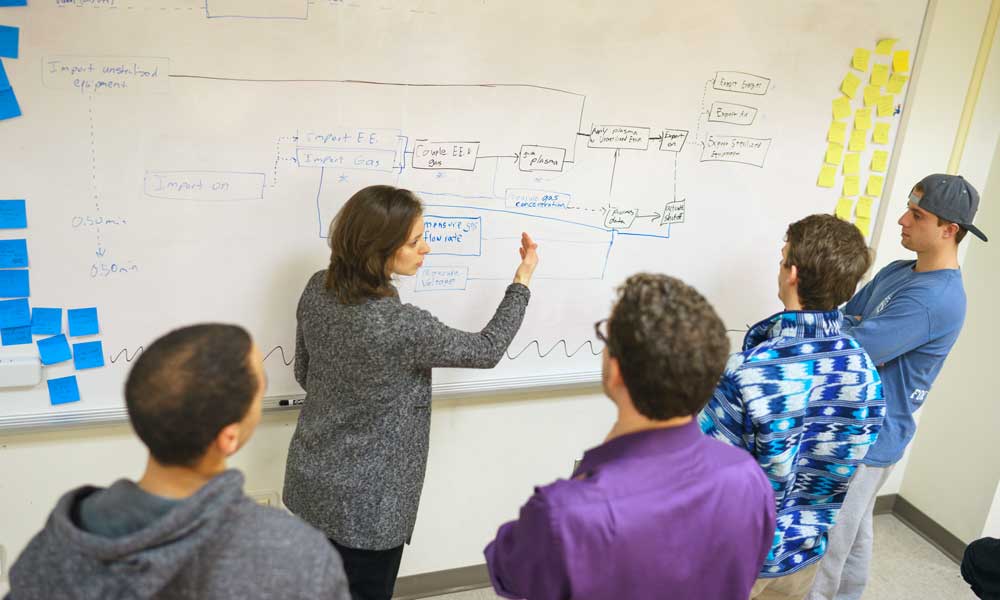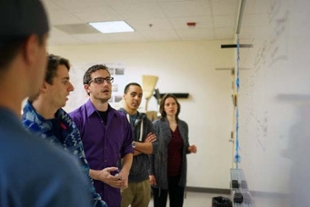Engineering students embark on space travel project for NASA
Science and Technology
It's a space nut's dream: Working on a project for NASA to remove an obstacle to sending astronauts into deep space.
For the next two years, engineering majors Quin Moore, Christopher Graves, J.P. Gaffney, Zach Duda and James Watkins will research, plan and build a prototype device for sterilizing medical equipment on manned missions to Mars and beyond.
"If something happens on the International Space Station and they need to make an emergency trip, they can come straight back to earth in a day or two,” said Watkins, secretary for the team that has dubbed itself Team M.O.B. (Mars or Bust). "But if you're on the way to an asteroid or to Mars, you can't just turn around and jump back if something goes wrong."
'I knew it was project based, but I think this has exceeded expectations. Some of my friends at other schools, they get semester-long capstones and we get two years to do this. So it's pretty cool.'
- Zach Duda
NASA is looking for a cold plasma-based sterilization system that is compact, low power and low volume. "They want something that is cold-plasma based because of all the safety advantages it provides in a confined space," said Dr. Jaquelyn Nagel, an assistant professor of engineering who is advisor for the project. Nagel first connected with NASA representatives at a conference in 2014, she said, and they expressed interest in JMU's two-year capstone model. For the past year she has been working with a representative of the NASA Langley Research Center to design the project.
In a description of the project, NASA states that the advantages of cold plasma sterilization include the absence of toxic agents used or produced and quick microorganism (e.g., germs, spores) inactivation. Such a system also would not damage synthetic or metal items while killing microorganisms that traditional sterilization methods cannot.
It's not exactly the kind of project the five juniors expected to be working on when they entered the engineering program.
"I knew it was project based, but I think this has exceeded expectations," said Duda. "Some of my friends at other schools, they get semester-long capstones and we get two years to do this. So it's pretty cool."
Graves started at JMU majoring in music before switching to engineering. He said he wasn't sure what to expect and entered the program with an open mind.

"Telling people I'm working on a project with NASA in college, that's pretty cool."
- James Watkins
All five members of the team were selected for the project based on resumes and interviews. "For the most part, I think it was everyone's first choice," Graves said. "We had to choose out of three projects and rank which was first and second and third."
Watkins said, "I think most of us are pretty much space nuts so we've been reading about NASA, at least for me, the whole time I was growing up. So telling people I'm working on a project with NASA in college, that's pretty cool."
And while they may be tempted to jump right in and get their hands dirty designing and building the device, they learned during the first two years of the program that some research and preparation has to be done first.
"When you start to look at the technology, you go, 'Wow, that's cool. I totally want to try that. Let's try this, let's try that,'" Watkins said. "But there's no point in starting to try anything and wasting the money on building these prototypes if we're not actually going to solve the needs of the customer."
During a recent team meeting, Nagel urged the students to utilize the approach they learned working on their sophomore project. "Sophomore year was your foundation for capstone," she said. "In that experience, everyone had the same project. Now everybody has a different project, but the process is the same. So you should be taking these raw statements from the customer, this information that you're gathering and turn it into objectives, needs, requirements, constraints."
This semester’s agenda includes a literature review, codes and standards review and a set of system requirements. In the spring, the project will be more design-based and will be formally presented to NASA. During the 2016-17 school year, a working prototype will be generated and the project will be tested and finalized.
So who among the group would want to accompany their device if it did go into space?
“I wish,” Duda said.
“I’d do that in a heartbeat,” Gaffney said.
By Rachel Petty ('17), JMU Public Affairs
